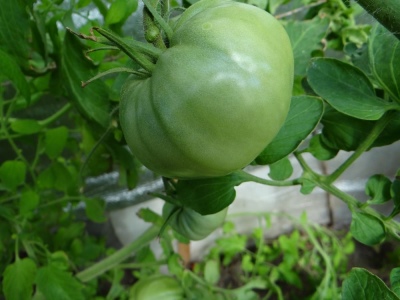
- Authors: Dederko V.N., Yabrov A.A., Postnikova O.V.
- Year of approval: 2005
- Category: grade
- Growth type: determinant
- Appointment: fresh consumption, for juice, for ketchup and tomato paste
- Ripening period: mid-season
- Ripening time, days: 100-110
- Growing conditions: for open ground, for film greenhouses
- Bush size: undersized
- Bush height, cm: 80-100
Tomato Tsar Bell is one of the best varieties of the Siberian collection, which includes crops with unique characteristics. It will appeal to all lovers of large tomatoes, and thanks to the delicate delicious sweetness of the fruit, it is suitable even for a dietary menu.
Breeding history
Tomato Tsar Bell was bred in the early 2000s by the famous Novosibirsk agronomist and breeder Dederko V.N., together with such specialists as A.A. Yabrov and O.V. Postnikova. He is the originator of many cold-resistant and tasty varieties of tomatoes. The culture has been tested in different regions, since 2005 it has been included in the State Register of Breeding Achievements in the Russian Federation for horticultural farms for growing in a greenhouse and in the open field.
Description of the variety
Tsar bell is a determinant plant, belongs to the standard type. In this regard, it stops growing when all the flower brushes are formed. The bush is undersized, compact. In the open air, its height is no more than 80-100 cm, in greenhouses it can reach 1.5 m.
The stem is powerful, strong. The leaves on the bushes are large, painted in a dark green tint. The first simple inflorescence will be formed over the 9th leaf, the subsequent ones after 1-2 leaves. The stalk of tomatoes is articulated. There are 4 ovaries per hand.
The main qualities of the fruit
The main difference between the Tsar Kolokol variety is large fruits, the weight of which reaches 600 g. However, on average, this indicator is lower: from 211 to 350 g. It is interesting that the shape of slightly elongated heart-shaped fruits may differ: there are specimens with both pointed and rounded top ... Often, the fruits of the variety are characterized as pear-shaped.
An unripe tomato is colored green, there is a dark spot around the stalk. When ripe, the tomato color changes to a rich red, often with a raspberry tint. The rind is firm and smooth, the fruit does not crack. The number of seed nests is from 3 to 4.
Taste characteristics
The taste of fresh tomatoes Tsar Bell is characterized as excellent, including a sweetish tint and sourness, balanced. The pulp is juicy, fleshy, not watery. Vegetables are consumed mainly fresh. And also used for the preparation of juices, pasta, ketchup.
Ripening and fruiting
The ripening period of tomatoes Tsar Bell is 100-110 days, if you count from the moment the seeds are immersed in the ground for growing seedlings. If the gardener has chosen the correct growing technique, it will be possible to feast on delicious tomatoes in July.
Yield
The Tsar Bell belongs to high-yielding crops. As a rule, farmers get from 8.6 to 18 kg of marketable fruit from 1 m 2.
The timing of planting seedlings and planting in the ground
Since the described variety is grown almost throughout the country, the timing of sowing seeds and transplanting seedlings into the ground are variable, differ depending on the region.

Growing tomato seedlings is an extremely important process, because it largely depends on whether the gardener will be able to harvest at all. All aspects must be taken into account, from seedbed preparation to planting in the ground.
Landing scheme
The cultivation of large-fruited varieties, as a rule, requires space.Therefore, no more than 2-3 compact bushes of Tsar Kolokol tomatoes can be placed on 1 m 2 of area. As they grow, they become spreading. Therefore, the plant should be provided with sufficient space for nutrition and development of the root system.

Growing and care
Tsar Kolokol is a high-yielding tomato crop grown in open beds and in greenhouses. The originators recommend forming a culture of 1–2 stems, removing unnecessary stepchildren. Considering the fact that the bush can grow quite powerful, and each bunch contains heavy berries, it is imperative to use a support or trellis to tie up heavy branches (in some cases, it is worth tying each brush).
In general, the cultivation of the variety is not particularly difficult and includes all the traditional measures, such as watering, loosening the land around the bush, mulching, preventive treatment, feeding with organic matter and mineral fertilizers.




A plant needs different micronutrients at each stage of growth. All fertilizers can be divided into two groups: mineral and organic. Folk remedies are often used: iodine, yeast, bird droppings, eggshells.
It is important to observe the rate and period of feeding. This also applies to folk remedies and organic fertilizers.
Disease and pest resistance
The Tsar Kolokol variety is quite resistant to the main diseases of the nightshade.


Resistant to adverse weather conditions
The culture in question can withstand almost any unfavorable weather conditions.
Growing regions
The Tsar Bell tomato is successfully grown in various regions of the country. These include the Northern and Northwestern, Central regions and the Central Black Earth Region, the Volga-Vyatka, Middle and Lower Volga regions, as well as the North Caucasus, Western and Eastern Siberia, the Urals and the Far East.

























































































